Where land meets sea, and South meets North
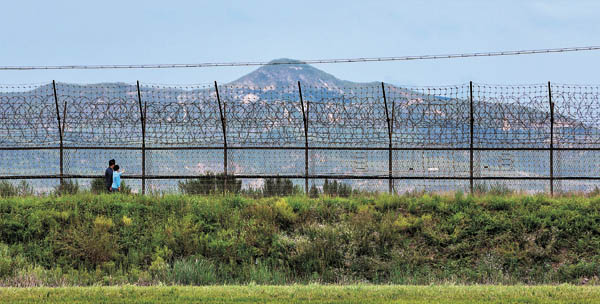
From Gyodong Island, which is in Ganghwa County, Incheon, it’s possible to get a glimpse of North Korea. Beyond the wire fence is Yeonbaek County, Hwanghae Province.By Lim Hyun-dong
Korea’s fourth-largest island is surrounded by many small islands. Of the 26 minor islands in Ganghwa County, Incheon, only nine are inhabited.
Of all the sub-islets, Gyodong Island and Seokmo Island are among the largest based on area and population. While the two islands are both characterized by mountains, they offer very different experiences.
Gyodong Island is located within the civilian access control line, very close to the border with North Korea. In fact, it is possible to see Yeonbaek County in Hwanghae Province, North Korea, only about two kilometers (1.2 miles) away, and it can be seen with the naked eye.
The island made the news during the recent tensions between North and South Korea because some residents temporarily fled, but Gyodong Island is usually surprisingly calm and a quiet place to live despite its proximity to the North.
Despite its location beside the border, the island has never been the site of military conflict since the Korean War. And anyone can approach the wire fence and look across into the Hermit Kingdom.
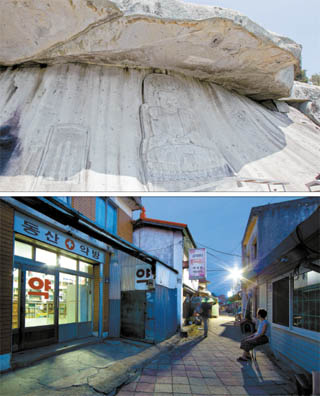
Top: Visitors to Seokmo Island often go to Bomun Temple to see the giant engraved Buddha beneath a rock ledge that is said to make wishes come true. Above: Many of the stores at Daeryong Market on Gyodong Island have been there for over 50 years, giving visitors the feeling of traveling back in time to the 1960s.
While Gyodong Island has rarely seen many visitors until recently, Seokmo Island has long been a popular destination for its superb landscape which harmonizes the mountains and the sea. A ferry to the island started running in the 1990s and the number of tourists skyrocketed.
Unlike Gyodong, Seokmo Island is filled with restaurants and guest houses that cater to visitors. During the summer vacation season, about 20,000 people visit the island by ferry.
The already popular island will soon see even more visitors with a new bridge connecting the island to Ganghwa Island opening in 2017.
Where time stopped
Since Gyodong Island hasn’t historically been a popular tourist spot, the small island still has many small markets and shops, relics of a past era.
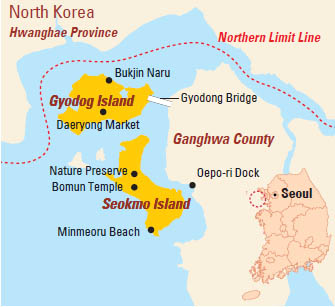
Some of the owners of these old stores are those who left their homes in what is now North Korea during the Korean War. Ji Gwang-sik, who owns the Gyodong Barber Shop, left his hometown of Yeonbaek, Hwanghae Province.
“It’s been 65 years since I initially meant to flee temporarily during the war,” he said. “There were about 30,000 people who fled their hometowns to this island, but now there are less than 100.”
Inside the old barber shop are combs, scissors, brushes and other items that look as if they are more than 50 years old. Ji’s certificate to be a barber hanging on the wall is dated July 10, 1965.
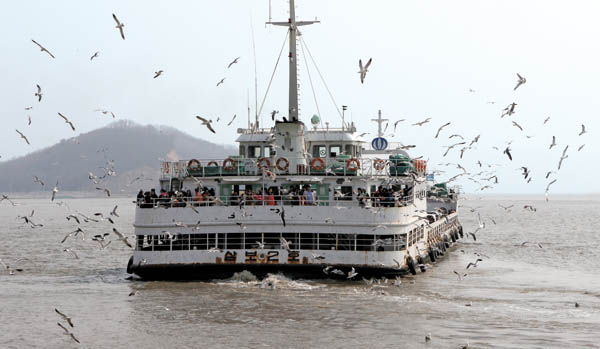
Seagulls swarm around the ferry to Seokmo Island as the passengers on board toss them shrimp-flavored snacks. Right: Minmeoru Beach on Seokmo Island has sand as well as mud flats where visitors can dig for clams.
“At one point, rice production from Gyodong Island was enough to feed the residents of Incheon for three years,” said Han. “Still, the rice from the island is famous.”
At the edge of the reclaimed land is a wire fence. Through the fence one can see Yeonbaek County in Hwanghae Province.
“When the weather is nice, one can see a dog playing around the town there,” said Han.
“There were some stories after the war of children swimming across the ocean to go look at the five-day Yeonbaek Market,” Han added. The shortest distance from the island to Yeonbaek County in North Korea is two kilometers.
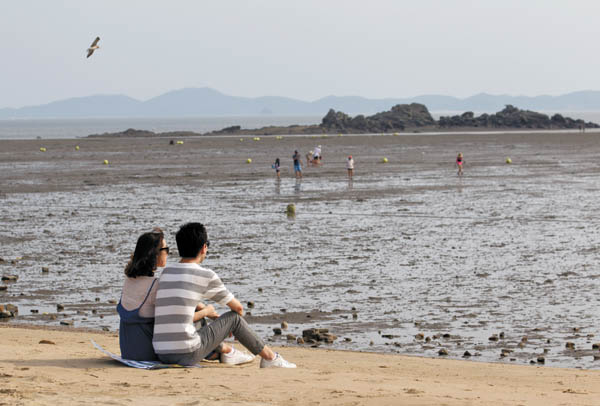
From Gyodong Island, which is in Ganghwa County, Incheon, it’s possible to get a glimpse of North Korea. Beyond the wire fence is Yeonbaek County, Hwanghae Province.By Lim Hyun-dong
Although the recent inter-Korean dispute did affect this quiet island, with the South Korean military placing loudspeakers on there in order to broadcast propaganda toward the North, the locals have long been trying to act as peacekeepers.
Kim Yeong-ae, head of the Seaurinuri Peace Movement, is working on making a Peace Trail along the fence.
“Gyodong Island is the only place where people can get close to the fence without any military intervention and see the land in the North,” Kim said.
“By walking along the fence, one can feel the importance of peacekeeping, and that means that one day the fence will be a symbol of peace instead of a symbol of separation.”
Where seagulls are your friends
To get to Seokmo Island, visitors must board a ferry leaving from Oepo-ri Dock on Ganghwa Island. Around the dock are many stores selling piles of shrimp-flavored snacks, which is a favorite treat of seagulls. Many tourists buy the snacks to feed the birds while riding the ferry across to the small island.
Most of the passengers onboard spend the ride on the upper deck so that they can feed the seagulls. More than 100 seagulls swarm around the ship and swoop down on the snacks in outstretched hands, bringing smiles to the adults and children on board.
Some travelers treat the exercise as a sort of ritual, flinging snacks into the sea while praying. One middle-aged woman said that she prayed for her daughter to pass the bar exam.
But the fun doesn’t last long, as the ferry ride only takes about 10 minutes.
The most popular destination on the island, where many visitors head as soon as they arrive, is Bomun Temple, located in the hills of Mount Nakga at an altitude of 245 meters. The temple, which was built in 635 during the Silla Dynasty (57 B.C. to A.D. 935), is a common destination for those who want to wish for something good to happen, for many believe that praying at the temple results in their wishes coming true.
Strings of lotus lanterns line the trails to the temple’s main Buddha statue, each bearing the wishes of visitors for family health, successful businesses, the sale of houses and more.
Another popular spot to visit to enjoy the water is Minmeoru Beach located on the southern part of the island. There is a sandy beach area, but people usually head to the mud flats, which expand as the tide ebbs, to try their hand at catching sea creatures such as crabs and clams.
Near the beach is Janguneomeo Harbor, a famous spot to watch the sunset. There is also Eoryujeong Harbor, where many restaurants serving all types of seafood are located.
A new addition to the tourist track is Seokmodo Natural Forest, located on the northern side of Mount Nakga. The nature preserve opened in 2011 and has become popular thanks to the inexpensive guesthouse options there. And it is the only nature preserve in Ganghwa County.
There is a new arboretum inside the preserve, but since the place has not yet been officially opened, visitors can go in and take a quick look around the area without paying an additional fee.
BY CHOI SEUNG-PYO [summerlee@joongang.co.kr]










with the Korea JoongAng Daily
To write comments, please log in to one of the accounts.
Standards Board Policy (0/250자)